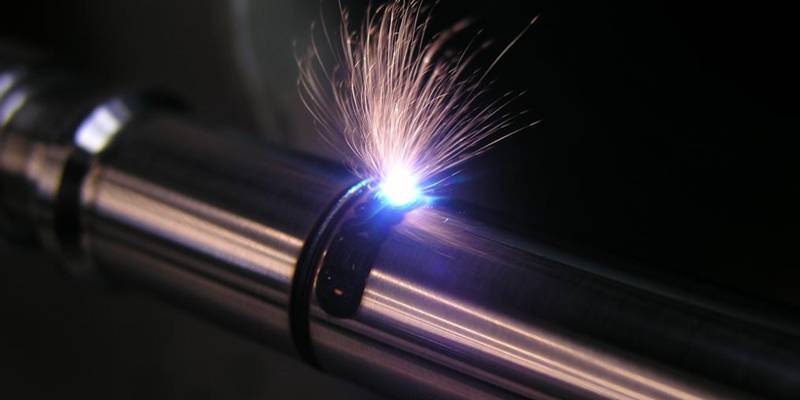
Laser marking is a range of marking techniques known for their permanent markings and wide material compatibility. Due to their reliability, efficiency and productivity, many industries prefer them over traditional marking systems such as manual engraving, stamping and screen printing.
The laser marking system allows manufacturers to apply permanent markings in the form of text, codes, graphics and numbers to parts and machines without damaging the surface. In this article you will learn everything you need to know about laser marking systems and their application in the manufacturing of parts and products.
What is laser marking?
Laser marking is a series of non-contact marking techniques used to create permanent marks on the surface of the part. The marking system is contactless as it uses a laser beam generated by a laser marking machine.
The laser marking process depends on the laser technology used. However, any laser technology can create permanent markings on many materials.
How does laser marking work?
To understand how the laser marking process works, you need to be familiar with a laser marking machine and how it generates the laser beam responsible for marking.
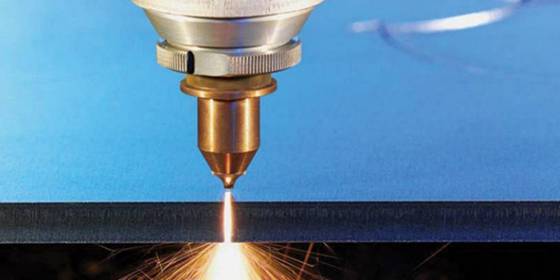
Step 1: Generation of the laser beam
Laser beam generation in any laser marking device depends on three important components:
● The laser medium is responsible for the axis position and the excitation energy required by the machine. Common laser media are neodymium-doped yttrium aluminum garnet (solid) and organic dyes (liquid) as well as CO2 (gaseous). The laser medium can also have a geometric shape, like fiber lasers.
● The pump source is responsible for supplying energy to the laser marking device, which excites the laser medium and leads to the emission of photons by spontaneous or stimulated emission.
● The optical resonator has a reflective mirror (high reflector) and a partially reflective mirror (output coupler). It reflects the light generated by the laser medium. It may also contain other elements, such as a modulator and a Q-switch, which can change the properties of the laser beam produced.
Energy is introduced into the laser medium. This leads to the excitation of the atoms in the laser medium and the emission of photons. Light enters the optical resonator and undergoes total reflection, producing the laser beam. The laser can then be passed to components such as Q-switches, lenses, beam expanders, etc. to shape the beam before release.
Step 2: Mark
When the laser beam touches the surface of the part, the thermal energy generated causes a change in the properties and characteristics of the material. The type of change depends on the laser technology chosen. A permanent mark is then left on the surface of the workpiece.
Why should you choose laser marking for parts production?
The laser marking process is preferable to other marking methods such as dot peening and inkjet marking. Below are some reasons why you should choose laser marking systems.
High speed
With a laser, you can easily create various designs and patterns on the material in a short period of time. This is different from traditional marking, where speed depends on the operator. Therefore, they are slower and therefore more time-consuming. Furthermore, the production of parts is more efficient due to their speed.
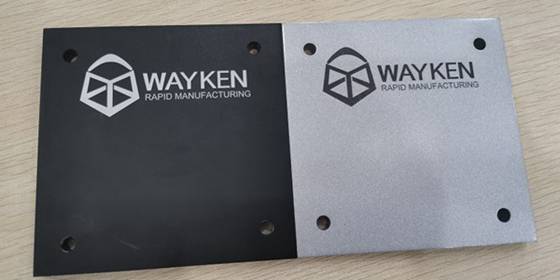
Permanent markings
Like the dot peen system, laser marking technologies produce permanent markings under harsh conditions such as: B. Chemicals. For this reason, it is preferred by parts manufacturers such as the automotive and aerospace industries due to the permanent marking. Permanent, long-lasting markings allow these manufacturers to track and identify their products regardless of where they are used.
Contactless process
The process is contactless. Therefore, there is no change in the physical properties of the material. Additionally, laser technology is popular in the manufacturing and production industries due to its contactless nature.
Environmentally friendly
Laser marking systems do not use consumables such as chemicals compared to inkjet marking. Therefore, there is less risk of releasing harmful materials into the environment. Furthermore, unlike dot peening, laser technology does not produce noise and is therefore environmentally friendly.
Common Types of Laser Marking Techniques
There are several laser marking systems that can be used in part manufacturing processes. Each has its own mechanism for using the laser. For example, laser engraving removes parts of a material. Therefore, it is applicable in logo or character processing. The three most common types of laser marking are:
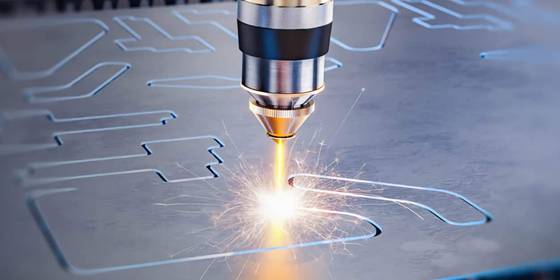
Laser engraving
Laser engraving is the most common marking method in part manufacturing and prototyping and is suitable for machining materials such as metals, ceramics and plastics. Like any laser marking method, it provides permanent markings, although they are less sharp than the others on the list.
Laser engraving is a subtractive process in which part of the material's surface is removed with a laser beam. The laser beam focused on the surface turns the removed material into plasma or vapor, which is removed by smoke exhaust. When removed, it leaves an engraving that can be easily felt with your fingers.
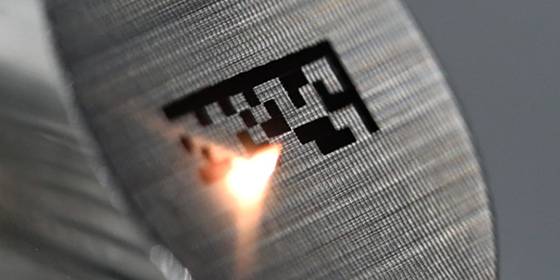
Laser engraving
Laser engraving is another marking method for creating permanent marks on a workpiece. It is widely used for metals such as aluminum, steel, stainless steel, lead, etc. The laser marking machine engraves the part by emitting pulsed laser beams onto the surface of the part. Upon reaching the surface, the material absorbs the beam and converts it into heat, melting and lifting the surface.
The laser engraved surface requires less energy because, unlike laser engraving, it has no depth. Plus, they are more visible. For example, laser engraved aluminum is more visible than laser engraved aluminum.
Laser annealing
Laser annealing is a non-subtractive process often used for products with high dimensional accuracy. Metal surfaces are heated and cooled slowly using laser beams to change their color (yellow, red or green) depending on the temperature of the metal surface.
The laser annealing process is not suitable for non-ferrous metals and aluminum because their colors are not changed by the effects of heat and oxide.
Types of laser marking machines
There are many lasers, but we will discuss the four most commonly used to mark production parts.

CO₂ laser marker
CO₂ laser markers use CO₂ as the laser medium and are the most suitable marking system for organic materials (they are also suitable for metals after the metal has been treated with a special marking agent that gives it a high-contrast permanent mark) .
They have the longest wavelength (10,600 nm) of any laser marking system, which makes them useful for marking various materials depending on the needs of different industries. Additionally, they also offer faster marking speeds when working with thick materials, especially when laser cutting sheet metal.
Although they are best suited for industrial applications, the maintenance costs and power consumption of CO₂ lasers are high. Also, they are slower than others.

fiber laser marker
Fiber laser markers are a newer, simpler and more versatile marking system that uses high-tech fiber optics as the laser medium. They are suitable for marking inorganic materials such as metal, steel, aluminum, etc.
The fiber laser marking system has high marking speeds and consumes less energy. Furthermore, maintenance effort is low. However, they are unsuitable for marking thick materials.

Green laser markers
Green laser markers have a high wavelength (532 nm). They are suitable for marking highly reflective and sensitive materials such as circuit boards, soft plastics, etc. Furthermore, they produce high-precision markings on workpieces and can absorb different types of materials.

MOPA laser marker
Master Oscillator Power Amplifier (MOPA) lasers are suitable for creating black marks on high-quality metals and plastics. They use a master oscillator to generate the beam and the power amplifier increases the output power.
Normally the pulse duration cannot be adjusted with laser markers. With MOPA lasers, however, the pulse duration and energy can be adjusted. They are therefore very flexible.
Other methods for direct marking of parts in machining production
There are other marking techniques with a wide range of industrial applications. The three most common marking techniques are:
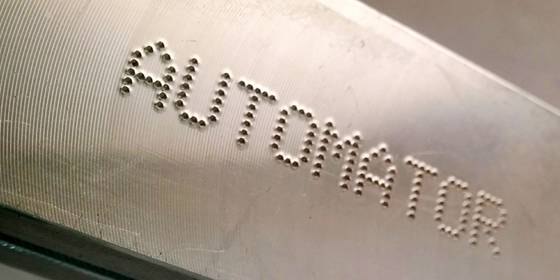
Needle engraving
The micropercussion system uses a carbide or tungsten carbide tip to create deep and permanent marks, pneumatically or electrically. Unlike laser markers, dot engraving does not create thermal shocks on the surface of the material. However, due to their mechanical strength, they are only suitable for long-lasting parts.
Inkjet marking
Inkjet is a non-contact process that marks a part with ink. There are two types of inkjet marking: thermal and chemical.
-Thermal inkjet printers have print heads that use heat to transfer ink to the surface of the material. They are suitable for marking sensitive parts such as food packaging and medical devices.
– Chemical inkjet printers are more complex and use specialized inks and papers to print on a wider range of materials, such as glass, metals and plastics.
Chemical Etching
This subtractive process uses chemical sprays to remove materials from the surface of the workpiece and create a permanent etching on the metals.
This involves printing a design or logo onto a photoresist, exposing it to UV light, and then placing the laminated design onto the metal surface. The exposed portion is etched when you expose the design to an etching solution such as ferric chloride.
Meet your different laser marking needs at WayKen
You need laser marking systems to permanently mark machined parts. This article provides some basic knowledge about tagging systems. However, it is very important to work with experts who can provide top-notch laser marking services.
Concluding
Laser marking is the best and most widely used marking method for creating high-quality, clear, permanent markings on various materials. They are easy to use and preferable to old traditional marking methods. This article describes the process and explains why it is the most effective option for different industries.
Common questions
What materials can be marked with a laser?
Laser markers can leave permanent marks on most metals, plastics, ceramics, glass, rubber and silicone. You can also engrave rare gemstones such as rubies, diamonds and sapphires.
What applications are there for laser marking?
Laser markings are widely used in industry for traceability and part identification. Manufacturers can use laser marking to add expiration dates, barcodes, manufacturing dates, and logos to products. Therefore, laser marking technologies are used in the food, medical, aerospace, automotive and electronics industries.
Does the marking lose strength?
No, that is not the case. Laser markings leave permanent marks on the surface of the material. However, in rare cases, under severe conditions, markings may disappear as the surface of the material erodes.

























































